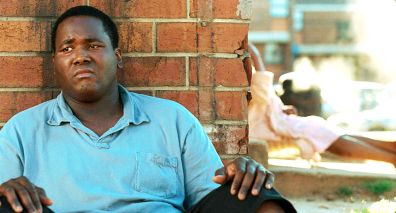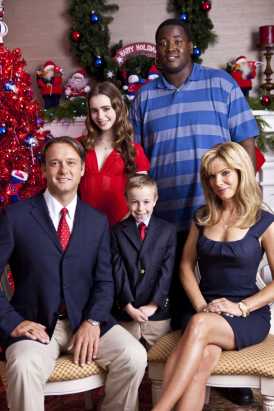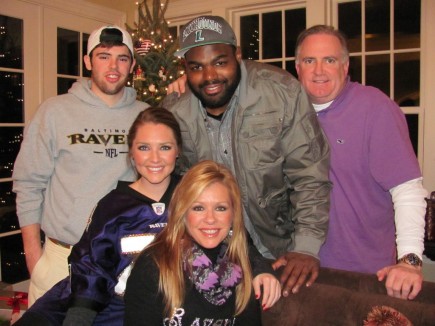I’m going to start this post by saying that I love film, and I own a growing collection of movies that I regularly turn to for every type of mood. I have films that bring me out of bad moods, make me laugh, make me think, and just provide general feelings of hope and happiness.
One movie that I love is the popular The Blind Side, starring Sandra Bullock as the tough mom Leigh Ann Touhy. The film won numerous awards, including an Academy Award for Bullock for best actress, and even grossed about $255 million total. It’s one of those “faith and family first” films that shows the struggle of a black teen named Michael Oher, who grew up with a drug-addicted mother in the projects. Leigh Ann Touhy notices him walking home alone one night, offers him a warm place to sleep, and the story goes from there.
Let me just say that I love this movie, and I love Leigh Ann Touhy in real life. I’m a sister of Kappa Delta Sorority, as is she, and I think that she’s a blessed, strong-willed Southern woman who tries to do the right thing. The story is beautiful, and in the end, Michael Oher is adopted by the Tuohy family and successfully goes on to Ole Miss University on a football scholarship and now plays for the NFL. It’s heart-warming, really.
In our pop culture class last week, we discussed race and ethnicity in popular culture; we learned that racially, white people are primarily shown in the media, and those of other races or non-white actors are often stereotyped or given the burden of representation (being the only person having to represent their entire racial group). My critique of the film is intersectionally from a white, heterosexual, female’s perspective, and I’ve attempted to see this film from a point-of-view unlike my own. What I’ve come to understand from this movie is the idea of a “white savior” like we discussed in class; based on a true story or not, The Blind Side depicts white woman Leigh Ann Touhy “saving” black Michael Oher from his broken family, fake friends, and desperate situation by giving him a home, sending him to a [primarily white] private school, and giving him “opportunities.” While it’s a noble effort, the way the situation is portrayed in the film shows white people as being higher than blacks; the entire Touhy family, students and teachers at the private school, his tutor, etc. are all white, while the “bad” situation where Michael came from- with drugs, alcohol abuse, and poverty- was shown as including only black people. Does that mean that whites can’t be poor and addicted to drugs? Absolutely not. However, this movie is constantly shown on TV networks like ABC Family since it promotes “family values,” which could give children watching it a false idea of what it means to be black and white.
I also understand that this film is based on a true story, and like I mentioned earlier, I think that Leigh Ann Touhy and her family are amazing in real life. I truly admire her and even keep up with her on social media. However, I think it’s crucial that we take a step back from this stereotype of a white person “saving” a person of another race or minority, even if they throw in the cheesy “I’m saving his life, but he’s also saving mine” quote (which does make for a sweet moment in the movie).
In class, we discussed an article entitled What Does Race Have to Do With ‘Ugly Betty?’: An Analysis of Privilege and Postracial (?) Representations on a Television Sitcom by Jennifer Esposito. In the article, Esposito discusses the white character Daniel as a “great white hope,” because he heroically swoops in to save Betty with a great recommendation of her character after she is accused of only getting a prestigious internship because of her race (affirmative action). Similarly, The Blind Side shows Leigh Ann Tuohy swooping in to save Michael Oher; and while some may argue that she was just doing so because it was her Christian duty or the right thing to do, we have to view the premise of this situation in the film from an object point of view. What messages are being sent when a black boy is removed from a negative situation (only surrounded by other poor black people) and taken to a positive situation (surrounded by successful, wealthy white people), where he succeeds? In the movie, race is even talked about; when taking a photo for a Christmas card, Leigh Ann invites Michael to join her beautiful, perfectly groomed family for another picture. After being questioned by her family, she responds with, “What? It’s not like I’m going to put it on the Christmas card.” But in fact, the photo is used, which prompts a phone call from a relative: “This is Bobby, Happy New Years. Listen I’ve had about five cold ones and, uh, I’m just going to go ahead and ask — did you all know there’s a colored boy on your Christmas card?”
The Christmas card photo in the film
I totally understand that this film takes place in the South, and racism is still alive in the United States. However, the entire story of this film depends on race, showing the wealthy, successful white people as having it all- as soon as a socially shy, large, young, black man is pushed into this world, it’s immediately questioned. He’s first seen by others as a potential threat or alien in this privileged world, but his potential is soon drawn out thanks to the efforts of a white family, friends, and private school. I still think this is a great film and that the acting is done well, but my point is that racially, we as a society need to move away from this stereotype of the “white savior,” especially when depicting “true stories” to solidify this stereotype and showing it on TV channels under the guise of promoting the values of family.
The Tuohy family


